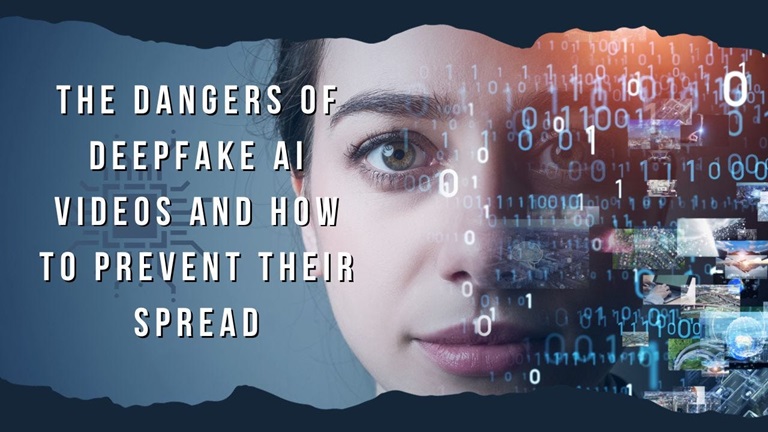Detecting and Regulating Deepfake Technology: The Challenges! Part II
The Challenges of Detecting and Regulating Deepfake Technology
The current state of deepfake detection and regulation is still evolving and faces many challenges. Some of the reasons why it is difficult to identify and prevent deepfake content from spreading online are:

1. Advancement and Ease of Access
The quality and realism of deepfake content are improving as the artificial neural networks that generate them become more sophisticated and trained on larger and more diverse datasets. The availability and affordability of deepfake software and services are also increasing, making it easier for anyone to create and share deepfake content online.
2. Non-Scalability and Unreliability of Detection Methods:
The existing methods for detecting deepfake content rely on analyzing various features or artifacts of the images, videos, or audio, such as facial expressions, eye movements, skin texture, lighting, shadows, or background noise. However, these methods are not always accurate or consistent, especially when the deepfake content is low-quality, compressed, or edited. Moreover, these methods are not scalable or efficient, as they require a lot of computational resources and time to process large amounts of data.
3. Complex and Controversial Regulations:
The legal and ethical issues surrounding deepfake content are not clear-cut or uniform across different jurisdictions, contexts, and purposes. For example, deepfake content may implicate various rights and interests, such as intellectual property rights, privacy rights, defamation rights, contract rights, freedom of expression rights, and public interest. However, these rights and interests may conflict or overlap with each other, creating dilemmas and trade-offs for lawmakers and regulators.
Furthermore, the enforcement and oversight of deepfake regulation may face practical and technical difficulties, such as identifying the creators and distributors of deepfake content, establishing their liability and accountability, and imposing appropriate sanctions or remedies.
Current and Future Strategies and Solutions to Detect, Prevent, and Combat Deepfake Technology
1. Social Media Platforms’ Policies:
Social media platforms can implement policies, guidelines, and standards to regulate the creation and dissemination of deepfake content on their platforms, by banning or labeling harmful or deceptive deepfakes, or by requiring users to disclose the use of deepfake technology. This strategy can be effective in reducing the exposure and spread of harmful or deceptive deepfakes on popular and influential platforms, such as Facebook, Twitter, or YouTube. Deepfake detection and verification tools, such as digital watermarks, blockchain-based provenance systems, or reverse image search engines can also be deployed to guide against the upload of any deepfake. These platforms can also collaborate with other stakeholders, such as fact-checkers, researchers, or civil society groups, to monitor and counter deepfake content. However, these solutions may face challenges such as scalability, accuracy, transparency, and accountability.
2. Detection Algorithms:
Detection algorithms can use machine learning and computer vision techniques to analyze the features and characteristics of deepfake content, such as facial expressions, eye movements, lighting, or audio quality, and identify inconsistencies or anomalies that indicate manipulation. Researchers can develop and improve deepfake detection and verification technologies, such as artificial neural networks, computer vision algorithms, or biometric authentication systems to improve detection algorithms.
They can also create and share datasets and benchmarks for evaluating deepfake detection and verification methods, and conduct interdisciplinary studies on the social and ethical implications of deepfake technology. This strategy can be effective in the analysis of features by identifying inconsistencies or anomalies that indicate manipulation. However, these solutions may face challenges such as data availability, quality, and privacy, as well as ethical dilemmas and dual-use risk.
3. Internet Reaction:
This refers to the collective response of online users and communities to deepfake content, such as by flagging, reporting, debunking, or criticizing suspicious or harmful deepfakes, or by creating counter-narratives or parodies to expose or ridicule them. Users can adopt critical thinking and media literacy skills to identify and verify deepfake content, and can also use deepfake detection and verification tools, such as browser extensions, mobile apps, or online platforms to sniff out deepfakes they encounter on social media or other platforms, which they can report or flag as deepfake content. The internet reaction strategy can be effective in mobilizing the collective response of online users and communities to deepfake content. However, these solutions may face challenges such as cognitive biases, information overload, digital divide, and trust issues.
4. Legal Response:
This is the application of existing or new laws and regulations to address the legal and ethical issues raised by deepfake technology, such as by protecting the rights and interests of the victims of deepfake abuse, or by holding the perpetrators accountable for their actions. Governments can enact laws and regulations that prohibit or restrict the creation and dissemination of harmful deepfake content, such as non-consensual pornography, defamation, or election interference. They can also support research and development of deepfake detection and verification technologies, as well as public education and awareness campaigns.
Some laws address deepfake technology in different countries, but they are not very comprehensive or consistent.
For example:
- In the U.S., The National Defense Authorization Act (NDAA) requires the Department of Homeland Security (DHS) to issue an annual report on deepfakes and their potential harm. The Identifying Outputs of Generative Adversarial Networks Act requires the National Science Foundation (NSC) and the National Institute of Standards (NIS) and Technology to research deepfake technology and authenticity measures. However, there is no federal law that explicitly bans or regulates deepfake technology. The incorporation of advanced TSCM Tools may become increasingly important to address emerging threats posed by deceptive audio and visual manipulation
- In China, a new law requires that manipulated material have the subject’s consent and bear digital signatures or watermarks and that deepfake service providers offer ways to “refute rumors”. However, some people worry that the government could use the law to curtail free speech or censor dissenting voices.
- In India, there is no explicit law banning deepfakes, but some existing laws such as the Information Technology Act or the Indian Penal Code may be applicable in cases of defamation, fraud, or obscenity involving deepfakes.
- In the UK, there is no specific law on deepfakes either, but some legal doctrines such as privacy, data protection, intellectual property, or passing off may be relevant in disputes concerning an unwanted deepfake or manipulated video.
Legal responses can be an effective strategy in fighting the dubiousness of deepfakes. However, these solutions may face challenges such as balancing free speech and privacy rights, enforcing cross-border jurisdiction, and adapting to fast-changing technology.
Recommendations and Directions for Future Research or Action on Deepfake Technology
DeepFake technology is still on the rise and rapidly evolving to better and more realistic versions every day. This calls for a need to be more proactive in tackling the menace that may accompany this technology. Below are some of the actions that I believe can be implemented to mitigate its negative impact:
- Verification and Authentication of Content: Consumers should always check the source and authenticity of the content they encounter or create, by using reverse image or video search, blockchain-based verification systems, or digital watermarking techniques.
- Multiple and Reliable Sources of Information: Consumers of digital media should always seek out multiple and reliable sources of information to corroborate or refute the content they encounter or create, by consulting reputable media outlets, fact-checkers, or experts.
- Development of Rapid, Robust and Adaptive Detection Algorithms and Tools for Verification and Attribution: There should be more focus on developing more robust and adaptive detection algorithms that can cope with the increasing realism and diversity of deepfake content, such as by using multi modal or cross-domain approaches, incorporating human feedback, or leveraging adversarial learning. New tools and methods for verification and attribution of digital content should be explored, such as by using blockchain-based verification systems, digital watermarking techniques, or reverse image or video search and more research is needed to develop and improve deepfake detection and verification technologies, as well as to understand and address the social and ethical implications of deepfake technology.
- Establishment of Ethical and Legal Frameworks and Standards for Deepfake Technology: More research should be made to create ethical and legal frameworks and standards for deepfake technology, such as by defining the rights and responsibilities of the creators and consumers of deepfake content, setting the boundaries and criteria for legitimate and illegitimate uses of deepfake technology, or enforcing laws and regulations to protect the victims and punish the perpetrators of deepfake abuse. More legal action is needed to enact and enforce laws and regulations that protect the rights and interests of the victims and targets of harmful deepfake content, such as non-consensual pornography, defamation, or election interference.
Actions should be coordinated, consistent, and adaptable, taking into account the cross-border nature of deepfake content and the fast-changing nature of deepfake technology, and should be balanced, proportionate, and respectful, taking into account the free speech and privacy rights of the creators and consumers of deepfake content.
- Promotion of Education and Awareness about Deepfake Technology: Future research or action on deepfake technology should promote education and awareness about deepfake technology among various stakeholders, such as by providing training and guidance for journalists, fact-checkers, educators, policymakers, and the general public on how to create, consume, and respond to deepfake content responsibly and critically.
- Report or Flag Suspicious or Harmful Content: Consumers should be aware of the existence and prevalence of deepfake content and should use critical thinking and media literacy skills to identify and verify it. They should be fast in reporting or flagging deepfake content that they encounter on social media or other platforms, by using the reporting tools or mechanisms provided by social media platforms, law enforcement agencies, or civil society organizations.
- Respect the Rights and Interests of Others: Producers of digital media should always respect the rights and interests of others when creating or sharing content that involves deepfake technology, by obtaining consent, disclosing the use of deepfake technology, or avoiding malicious or deceptive purposes. They should be aware of the potential harms and benefits of deepfake technology and should use it responsibly and ethically, following the principles of consent, integrity, and accountability.
Conclusion:
Deepfake technology has the potential to create false or misleading content that can harm individuals or groups in various ways. However, deepfake technology can also have positive uses for entertainment, media, politics, education, art, healthcare, and accessibility. Therefore, it is important to balance the risks and benefits of deepfake technology and to develop effective and ethical ways to detect, prevent, and regulate it.
To achieve this goal, governments, platforms, researchers, and users need to collaborate and coordinate their efforts, as well as raise their awareness and responsibility. By doing so, we can harness the power and potential benefits of deepfake technology, while minimizing its harm.
![]()







Leave a Reply